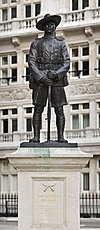Featured article 1
Portal:Nepal/Featured article/1

The Gurkhas, also spelled as Gorkhas, are soldiers from the South Asian country of Nepal. Historically, the terms "Gurkha" and "Gorkhali" were synonymous with "Nepali," and derived from the hill town and district of Gorkha from which the Kingdom of Nepal expanded. Legend has it that the name may be traced to the medieval Hindu warrior-saint Guru Gorakhnath Who are the Gorkha? Gurkhas are traditionally recruited from various Nepali hill ethnicities, but do not come from a single group or region in the multi-ethnic country.
Although the Gorkhas found in Himachal are mostly from Nepal, there have been reports of non-Nepalese Gorkhas (such as Thai Gorkhas, Naga Gorkhas and Chinese Gorkhas)
There are Gurkha military units in the Nepalese, British and the Indian army (Gorkhas) enlisted in Nepal. Although they meet many of the requirements of Article 47 of Protocol I of the Geneva Conventions regarding mercenaries, they are exempt under clauses 47(a)(c)(d)(e)&(f) similar to the French Foreign Legion.
Gurkhas are closely associated with the Khukuri, a forward-curving Nepalese knife and have a well known reputation for their fearless military prowess. The former Indian Army Chief of Staff Field Marshal Sam Manekshaw, once stated that "If a man says he is not afraid of dying, he is either lying or is a Gurkha."
Featured article 2
Portal:Nepal/Featured article/2

Pokhara (Nepali: पोखरा) is the second largest city of Nepal as well as the headquarters of Kaski District, Gandaki Zone and the Western Development Region. It is located 200 km west of the capital Kathmandu. Despite being a comparatively smaller valley than Kathmandu, its geography varies dramatically within just few kilometres from north to south. The altitude varies from 827 m in the southern part to 1740 m in the north. Additionally, the Annapurna Range with three out of the ten highest mountains in the world — Dhaulagiri, Annapurna I and Manaslu — are within approximately 15 - 35 miles as-the-crow-flies distance from the valley. Due to its proximity to the Annapurna mountain range, the city is also a base for trekkers undertaking the Annapurna Circuit through the ACAP region of the Annapurna ranges in the Himalayas.
Pokhara is home to many Gurkha soldiers. It is the most expensive city in the country, with a Cost of Living Index of 95.
Featured article 3
Portal:Nepal/Featured article/3
The Battle of Nalapani was the first battle of the Anglo-Nepalese War of 1814–1816, fought between the forces of the British East India Company and Nepal, then ruled by the House of Gorkha. The battle took place around the Nalapani fort, near Dehradun, which was placed under siege by the British between 31 October and 30 November 1814. The fort's garrison was commanded by Captain Balbhadra Kunwar, while Major-General Rollo Gillespie, who had previously fought in the Battle of Java, was in charge of the attacking British troops. Gillespie was killed on the first day of the siege while rallying his men and despite considerable odds, both in terms of numbers and firepower, Balbhadra and his 600-strong garrison successfully held out against more than 5,000 British troops for over a month.
After two costly and unsuccessful attempts to seize the fort by direct attack, the British changed their approach and sought to force the garrison to surrender by cutting off the fort's external water supply. Having suffered three days of thirst, on the last day of the siege, Balbhadra, refusing to surrender, led the 70 surviving members of the garrison in a charge against the besieging force.